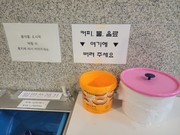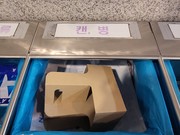“We must protect our planet.” It's a phrase we have heard so many times since we were children, and it's an obvious fact that we all know. But have you ever thought about what you are actually doing to try to save the planet? Also, is Chung-Ang University considering environmental issues seriously and actively implementing alternative measures? CAH intends to investigate environmental problems in the school and suggest ways to improve them through this article.
Is Chung-Ang University Eco-friendly?
The Campus Not Following Environmental Protection


The harmony between the lush trees and modern buildings of Chung-Ang University's Seoul campus makes the campus look beautiful and eco-friendly. However, if you look closer, you will see that this is not the case. It is easy to find plastic cups with leftovers and cigarette butts thrown away on the street, and these kinds of problems become even more serious at times such as festivals when people crowd around. CAU student Heo Da-hyeong (majoring in German Literature) said that “so much trash was rolling around, especially next to the food trucks. I think it is because there was no trashcan near the food truck zone.” In fact, lots of garbage was piled up around Building 303 (Law Building). Also, in many cases, you could find discarded paper cup holders in bins labeled as plastic and plastic containers with food left inside thrown away. These problems are partly due to the students' lack of awareness of the environment. However, it is not only the students who are responsible. The lack of adequate space to dispose waste within CAU is the school’s responsibility. Food and beverage waste bins exist throughout the school buildings, but not in all buildings or on each of the floors. Also, the systems, lectures, or public campaigns by the school to raise students’ awareness of environmental issues are insufficient.
Problems with Chung-Ang University’s Environmental Plans
Isn’t there any plan or system suggested by Chung-Ang University for the environment? CAU participated in the ‘Beyond ESG & Carbon Neutral 2030 Forum’, which was planned to lead carbon neutrality. The ‘Beyond ESG & Carbon Neutral 2030 Forum’ aims to shorten the time to achieve the carbon neutrality, originally planned for 2050, to 2030. The forum was led by Park Sang-gue, President of Chung-Ang University, and Sung Yun-mo, former Minister of Trade, Industry and Energy. However, the plans presented in this forum were just futuristic rather than solutions that can be acted on the present moment. In this activity, there was also a stage where university students could participate, but this also remained only at the stage of ideas rather than actual proposals that could be activated immediately. Overall, it can be seen that even though there are things that can be changed immediately for the earth with the direct participation of all students, there is no movement for real change.
Survey
The survey conducted among 82 Chung-Ang University students showed Chung-Ang University's inadequate measures for the environment, and the students' insensitivity to environmental problems. To the question asking the perception of students on how seriously they take environmental issues, 57.3% answered 'very serious' and 26.6% answered 'serious', showing that many students feel the problem is serious. However, there were few who answered that they themselves or the school are acting to protect the environment. The majority of students answered that CAU is not responding well to environmental problems both on campus and globally. To this, 79.3% of the students answered that that CAU should create an eco-friendly campus environment. Most of the students who answered that they are practicing environmental protection practiced small acts people can do in everyday life, rather than participating in group activities. The majority of students who answered that they do not practice environmental protection chose 'There will be no major change even if I act.’ as the reason. This seems to be connected with the insensitivity and helplessness to the current extreme environmental problems of the Earth and the avoidance of responsibility. Therefore, CAU should present alternatives to environmental problems that are not being implemented currently, and help students learn a sense of responsibility for environmental problems.
How Should Chung-Ang University Act to Environmental Issues?
Examples Overseas: Universities Acting for Earth
A university is not only an educational system, but also an institution that has been given a mission to meet the needs of society as a place of lifelong education. As a result, overseas universities are making efforts to create eco-friendly campuses in order to respond to global environmental problems that are intensifying recently. European universities have been promoting eco-campus based on the Copernicus Charter of the European University Presidents' Conference, which announced the role of universities for sustainable development. In the United States, many universities are making efforts to reduce greenhouse gas emissions and achieve carbon neutrality. One specific example, at UC Berkeley, the Office of Sustainability is running various student participation programs. With the support of the department, students who are interested in eco-friendly policies gathered and produced the “Green Campus Walking Tour,” made a map of eco-friendly places in the school and gave the map to not only students but also visitors. In the case of UC Los Angeles, students live in dormitories built with the theme of sustainable development, which also has a 'green dormitory' policy such as the program 'Sustainable Living Floor’, which provides education on eco-friendly lifestyles and a continuous discussion on sustainable development. These examples show that both Korean universities and students have significantly lower awareness of environmental problems compared to other countries and the need to improve them. In this situation, CAH believes that CAU, like the universities shown above, will be able to create a campus that considers the environment by the active support of the school and the participation of students.
Examples in Korea: A Road to Follow
Is there any environmental system that CAU can watch and learn from in Korea? Korean universities consume large amounts of energy every year. Accordingly, the Korean Ministry of Environment has been implementing the Green Campus project since 2011. However, CAU has not yet been selected as an annual Green Campus. This project is promoted so that universities, a major cause of greenhouse gases, can reduce greenhouse gases and nurture talented students who can lead sustainable growth. Selected universities must carry out eco-friendly practices such as installing new renewable energy systems such as solar power generation facilities, as well as green spaces for an environmentally friendly campus. In addition, college students can acquire information related to environmental issues through various campaigns hosted by the Ministry of Environment and various universities. CAH hope that CAU will carry out various eco-friendly activities as soon as possible even without any support since we have no time to waste.
A university is not simply an educational institution, but also a space to teach students about the important values they need to take attention to. Accordingly, not only the students' active attitude toward the global environmental problem, which has recently entered a serious situation, but also the right environment and education of the university is important. It seems that CAU lacked the correct attitude to actively protect the environment. Through this article, CAH investigated various environmental problems that exist in the school, as well as ways to improve them through examples of other schools. CAH hopes that this awareness of the problem will eventually lead to actual practice.

